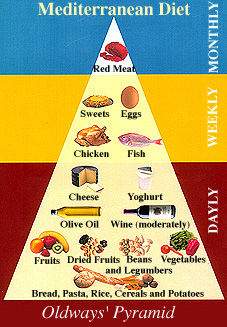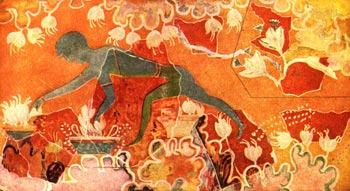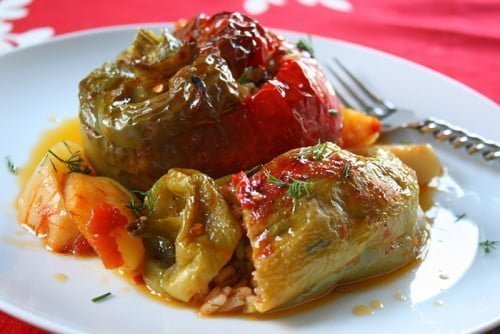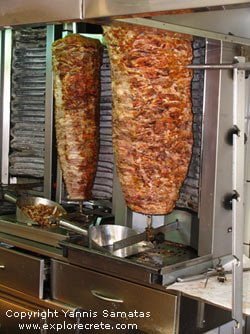Greek Souvlaki
The souvlaki is the best-known Greek food, a word that invokes Greece as much as the Acropolis, the Parthenon, retsina and ouzo. Anyone who’s visited Greece or who lives in a northern European or US city will have tasted the famous Greek souvlaki at least once. For those of you who haven’t been introduced to it yet, we’ll describe the souvlaki, present a few photos and give you an appetite for making your own at home.
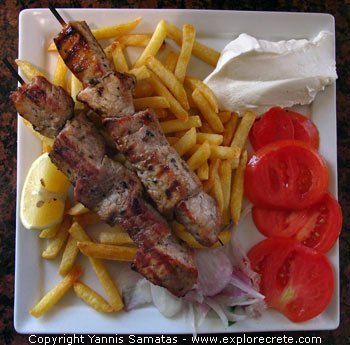
What is souvlaki?
Souvlaki is a fast food served in “souvladzidika” (souvlaki shops), small eateries that also serve gyros and other grilled meat dishes. You can buy one to take away and eat on the street or sit in the shop and enjoy it at your leisure.
Souvlakia are small cubes of pork threaded on a small wooden skewer (the “souvla”), also known as a “kalamaki”. The word “kalamaki” applies equally to the souvlaki itself.
Ordering at the souvlaki shop
- If you ask for “ena kalamaki parakalo” (one kalamaki please), you’ll get a mouth-watering souvlaki and a slice of bread.
- If you ask for “ena kalamaki me patates”, your souvlaki will be accompanied by chips.
- If you ask for “ena souvlaki pita”, you’ll get souvlaki meat (without the wooden skewer, of course) in pita bread like gyros pita, with yoghourt, tomato, onion and chips. This only applies in Crete, as in Athens you don’t get the chips.
- Of course you can pick the ingredients of your pita souvlaki, leaving out the onion or yoghourt, using mustard or ketchup instead, or whatever.
- If you’re a vegetarian don’t worry, just ask for a “patatopita”, a pita without the meat but with the yoghourt, tomato, onion and chips.
The history of souvlaki
Although the origins of the gyros are lost in the mists of time, there is no doubt about the souvlaki. The souvlaki first appeared in ancient Greece, as proved by a recipe from that time. The dish was called “kandaulos” and combined grilled meat, pita, cheese and dill (Athenaeus, The Deipnosophists, 12, 516d).
Many centuries later we find references to street vendors selling souvlakia with pita in Constantinople, the capital of Byzantium.
The first souvlaki shops in Greece appeared in Livadia in 1951, selling souvlakia on a stick and gyros.
Today souvlaki is available in souvlaki shops and restaurants in every Greek town and city. You can order it as a takeaway and of course you’ll always find it sold at canteens at street markets, on the beach or by the side of the road. At every festival there’s at least one vendor filling the air with the delicious smell of char-grilled souvlaki.
Types of souvlaki
Apart from the classic pork souvlaki, you can also try chicken or any other meat. One shop in Athens even serves ostrich souvlaki. All these variations were invented to provide a different taste, and also contain far less fat and cholesterol than pork.
In restaurants (but not souvlaki shops) the souvlaki is larger and threaded on a metal skewer. You can also order swordfish, prawn or vegetable souvlaki.
The traditional kebab is also cooked on a spit but it’s not called a souvlaki. It’s made of lamb or pork mince with spices and looks like a big elongated meat patty.
Souvlaki Recipes
Swordfish souvlaki
- Buy swordfish steaks. Fresh is best, but frozen will do if you can’t get it.
- Marinate the swordfish in a little oil, lemon and rosemary for one to two hours. Chop into small cubes when ready.
- Slice some tomatoes and thread both tomatoes and swordfish cubes on souvlaki skewers.
- Add salt and pepper to taste.
- Grill the souvlakia.
- You can add a side salad or boiled rice.
Pork souvlaki
- Buy pork steak and chop it into small cubes. Marinate in olive oil, oregano, thyme and a little vinegar for 8-10 hours.
- Add salt and pepper to taste when ready and thread the pieces on souvlaki skewers. Be careful not to grill on too high a heat as the meat will dry out.
- You can also grill pita bread and add some tomato, onion and the cooked souvlaki meat, served with yoghourt, mustard or ketchup.
- Add you favourite salad for a full, healthy and easy meal.
* Article and Photos by Yannis Samatas – All Rights Reserved.
LINKS:
- Souvlaki shops in Heraklion
© explorecrete.com All Rights Reserved. Reproduction or copying without permission is prohibited.

